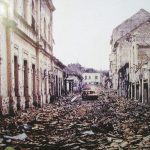26 years have passed since the fall of Vukovar.
Vukovar and Croatia today mark 26 years since the town fell into the hands of the aggressor after the bloodiest battle of the Homeland War and a three-month siege in which 1,624 Croatian war veterans and civilians were killed and the town was completely destroyed. After the Second World War, no major European town has been subjected to such destruction, with a direct material damage estimated at 9.5 billion kunas.
Thousands of people have arrived in the town in eastern Croatia which has become a symbol of the Homeland War, due to its months-long siege and crimes which were committed after the defenders surrendered. The central part of commemorations is a memorial procession which will once again start from the Vukovar hospital and end 5.5 kilometres further away, at the Memorial Cemetery, in order to pay tribute to the victims.
In addition to the highest government officials, the procession will include about half of all MPs, and it will be lead by Vukovar veterans and the families of the dead, detained and missing soldiers, together will 186 war flags from various units which took part in the Homeland War.
The commemorations began on Friday evening in the courtyard of the Vukovar hospital, where numerous citizens of Vukovar and hospital staff paid tribute to the victims of the aggression of the former Yugoslav National Army and paramilitary units in Vukovar in 1991. Candles were lit by President Kolinda Grabar-Kitarović, Vukovar Mayor Ivan Penava, Vukovar-Srijem County Prefect Božo Galić and others. “We came to lay the wreaths and light the candles in memory of the suffering of the town of Vukovar and its defenders and civilians, as well as all those people who laid down their lives for Croatia. Let them rest in peace,” said Galić.
Similar tributes could be seen in many other Croatian towns, where thousands of people lit candles on Friday evening, in the windows of their homes and along the local streets which carry the name of Vukovar. In Zagreb, the main commemoration was organised at Vukovar Avenue and Croatian Fraternal Union Avenue, where thousands of candles were lit. Two hundred white balloons were released into the air and along Vukovar Street citizens lit candles in honour of the victims. Interior Minister Božinović told reporters that they came to pay tribute to the victims of Vukovar. “You saw a lot of young people and children tonight, cadets from the police academy and the military, which is a guarantee that Vukovar will never be forgotten,” he said. Similar events were organised in many other towns as well.
Vukovar was under siege for 87 days, and the battle for Vukovar ended on 18 November 1991, with the occupation of the town which lasted until 15 January 1998 and the peaceful reintegration of the Croatian Danube region. Occupation meant that most non-Serbs from the town and surrounding settlements were forced to leave their homes. Also, war crimes were committed at Ovčara against the wounded soldiers and civilians and staff of the Vukovar hospital. Approximately 7,000 prisoners were taken to concentration camps in Serbia, and about 22,000 Croats and other non-Serbs fled the town. Hundreds of children were left without parents, and even today, approximately 300 people are considered missing.
Although fighting in Vukovar and the surrounding areas began earlier, the date when the real battle started is 25 August 1991, when the former Yugoslav Army and Serbian paramilitary units embarked on a massive attack on the town with tanks and infantry. At the time, the armed rebellion of a part of the Serbian minority in Croatia and the aggression of the Yugoslav National Army (JNA) against Croatia was at its peak, and all the battlefronts were active – Eastern Slavonia, Western Slavonia, Kordun, Banija, Lika, Dalmatia and Dubrovnik.
The JNA leadership assumed that Vukovar would fall within a week, but the fighting lasted for almost three months, during which Vukovar and the surrounding region were shelled and bombed daily, with frequent tank attacks. The balance of military power of the two sides was uneven. The Croatian forces in Vukovar never had more than 3,000 members while, on the other hand, the town was held under siege by about 30,000 soldiers of the Yugoslav People’s Army and Serbian paramilitary forces.
The attacks were executed by military planes, 400 tanks, hundreds of mortars and cannons. More than 6.5 million grenades were fired at the town, which was eventually annihilated. Defenders unsuccessfully attempted to unblock the town, which was surrounded starting from mid-October 1991.
Life in the besieged Vukovar was extremely difficult. There was no electricity and no regular supply of water and food. Most of the civilians were in the basements and hideouts for weeks. The town hospital was severely damaged, with only basement being operational and with corridors full of hospital beds. Convoys of the Red Cross and Doctors Without Borders tried to enter the town, evacuate the wounded and provide humanitarian aid.
The attack on Vukovar culminated in November when there were dozens of air strikes, and in some days up to 11,000 grenades, grenades and rockets fell on the town. Vukovar was occupied on 18 November, although the resistance of some groups of soldiers lasted until 22 November.
The battle for Vukovar was symbolically important for the ultimate breakup of Yugoslavia because during this battle the JNA completely transformed into an army which supported and implemented the Greater Serbian politics of then Serbian President Slobodan Milošević.
In the memory of 18 November 1991, the Croatian Parliament in 1999 decided to proclaim a memorial day for the victims of Vukovar in 1991 to honour all the participants of the defence of Vukovar, the town which has become a symbol of Croatian freedom.









